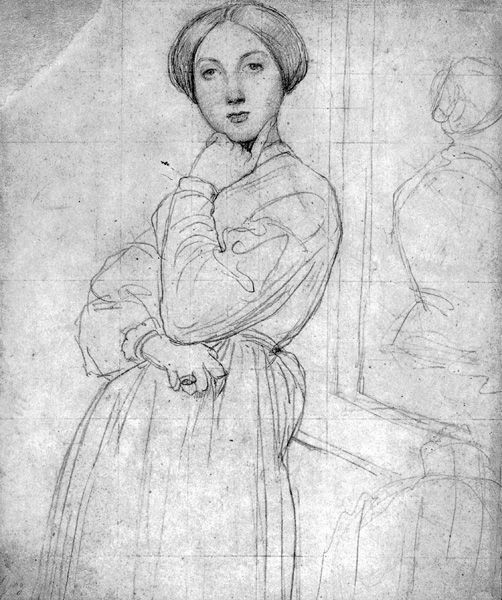Art has always been a tool of the famous and powerful. Artists themselves can become famous and powerful. In exploring the relationship between power and art one has to always remain focused on which audience any artist is working for and hoping to influence. Sometimes artists specifically aim to the future audiences, but often there is a select audience and sometimes the only satisfaction an artist is seeking is from the sitter or client who has contracted a portrait. Sometimes he only seeks to impress himself and no one else at the time is capable of understanding his goals.


One of the most interesting artists to explore for his relationships to his clients is the French painter Jean Auguste Dominique Ingres. This artist was born into the last years of the Rococo style and just before the French Revolution. When he was a young student, the style changed to Classical and the master at that time was David, who brought Ingres under his wing. The Napoleonic years shaped his career, but the turmoil in French society created violent gyrations, not only in the political and social lives of France’s citizens, but to all manner of life and art. Ingres certainly lived in interesting times…..



Throughout his life Ingres was reacting to the expectations of society, yet his choice, his main desire, was to produce large historical allegories that were the rage during his most productive years. These paintings are examples of how an artist can bend the will of the public into believing a past that is embellished, probably even false or non-existent.
But, to earn substantial commissions, he needed to do portraiture. The one chosen to illustrate this blog is of Louise de Broglie, Comtesse d’Haussonville, explained here much better than I by a curator from the Frick, where the painting now lives. In fact, at the point in his career that he took on this commission, he was so famous and accomplished he avoided portraits. But, Louise’ status in society and his relationship to this milieu required the commission to be completed. It took three years, over 80 drawings in preparation, and in the meantime the sitter became a Comtesse, pregnant and a mother. At the time when he completed this portrait and one of Baronne de Rothschild shown at the bottom, he was at the peak of his career. Both are exemplary of his skills with a brush. Close ups of Louise’ eyelashes attest to his meticulous attention to detail.

Yet, for all the realism apparent in this painting, it is also a grand example of slight of hand by the artist. Often Ingres will position body parts or add body parts to complete his composition as he sees fit. Aimee Ng points out examples in her presentation. In this particular example there is no physical way Louise could contort her right arm and shoulder to pose in this way. If you study the many drawings you understand how Ingres picks and chooses from his planning to cut and paste what he needs to portray the figure in the pose he desires.
In the painting of the Comtesse, Ingres presents a Comtesse who knows she is an alluring female. She is also confronting the viewer, at this intimate moment but also into the infinite future. Yet, she is not really prepared for this confrontation, having just returned from the opera to her home, and having just tossed off her wrap and removed her gloves, which have been placed behind her on the mantel. She has also started to let down her hair. Yet, the coquettish pose causes the viewer to pose his own question as to what is on Ms. de Broglie’s mind.
If you are sufficiently intrigued at this point to continue on, the real point of this blog is to introduce you to one of our favorite pastimes that have arisen out of the Covid era. The Frick Museum, now closed for half a year, decided to present its works to the public through a series of online platforms. There are three: Cocktails with a Curator, The Frick Five and Travels with a Curator. I hope you take twenty minutes or so of your day or evening to watch the one presented here and then move on to the many others available on YouTube. There are two curators at the Frick who present, Aimee Ng, who presents this one, and Xavier Salomon, who came up with the idea. Both are fabulous. Ms. Ng’s background on the painting, the Comtesse and the painter will surely entertain and inform you. The efforts the two curators represent one of the examples when Covid has pushed our creative buttons and allowed the world an intriguing opportunity to grow, learn and relish life in the time of pandemic……Stay safe

https://www.theartstory.org/artist/ingres-jean-auguste-dominique/artworks/
https://www.nortonsimon.org/learn/multimedia/videos-podcasts-and-lectures/ingres-s-comtesse-d-haussonville-on-loan-from-the-frick-collection/ audio about the portrait